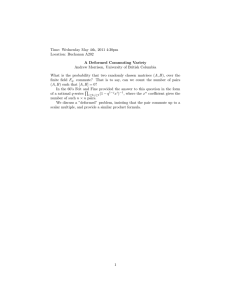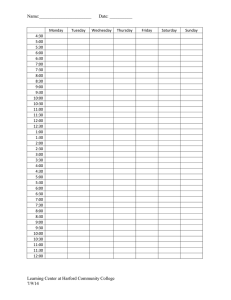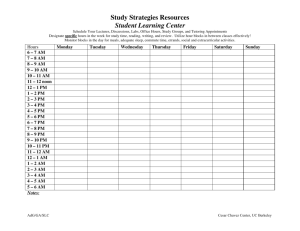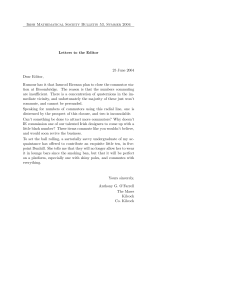ReseaRch Factors Affecting Commute Times in the 1990s
advertisement
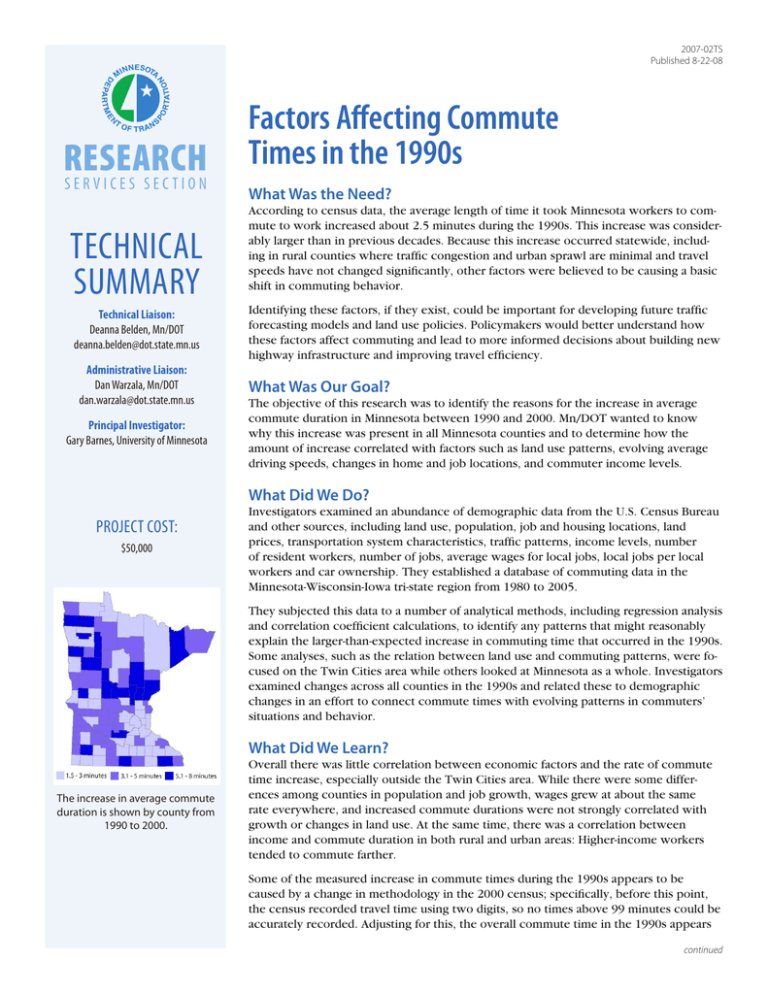
2007-02TS Published 8-22-08 Research Services section Technical Summary Technical Liaison: Deanna Belden, Mn/DOT deanna.belden@dot.state.mn.us Administrative Liaison: Dan Warzala, Mn/DOT dan.warzala@dot.state.mn.us Principal Investigator: Gary Barnes, University of Minnesota Factors Affecting Commute Times in the 1990s What Was the Need? According to census data, the average length of time it took Minnesota workers to commute to work increased about 2.5 minutes during the 1990s. This increase was considerably larger than in previous decades. Because this increase occurred statewide, including in rural counties where traffic congestion and urban sprawl are minimal and travel speeds have not changed significantly, other factors were believed to be causing a basic shift in commuting behavior. Identifying these factors, if they exist, could be important for developing future traffic forecasting models and land use policies. Policymakers would better understand how these factors affect commuting and lead to more informed decisions about building new highway infrastructure and improving travel efficiency. What Was Our Goal? The objective of this research was to identify the reasons for the increase in average commute duration in Minnesota between 1990 and 2000. Mn/DOT wanted to know why this increase was present in all Minnesota counties and to determine how the amount of increase correlated with factors such as land use patterns, evolving average driving speeds, changes in home and job locations, and commuter income levels. What Did We Do? Project cost: $50,000 Investigators examined an abundance of demographic data from the U.S. Census Bureau and other sources, including land use, population, job and housing locations, land prices, transportation system characteristics, traffic patterns, income levels, number of resident workers, number of jobs, average wages for local jobs, local jobs per local workers and car ownership. They established a database of commuting data in the Minnesota-Wisconsin-Iowa tri-state region from 1980 to 2005. They subjected this data to a number of analytical methods, including regression analysis and correlation coefficient calculations, to identify any patterns that might reasonably explain the larger-than-expected increase in commuting time that occurred in the 1990s. Some analyses, such as the relation between land use and commuting patterns, were focused on the Twin Cities area while others looked at Minnesota as a whole. Investigators examined changes across all counties in the 1990s and related these to demographic changes in an effort to connect commute times with evolving patterns in commuters’ situations and behavior. What Did We Learn? The increase in average commute duration is shown by county from 1990 to 2000. Overall there was little correlation between economic factors and the rate of commute time increase, especially outside the Twin Cities area. While there were some differences among counties in population and job growth, wages grew at about the same rate everywhere, and increased commute durations were not strongly correlated with growth or changes in land use. At the same time, there was a correlation between income and commute duration in both rural and urban areas: Higher-income workers tended to commute farther. Some of the measured increase in commute times during the 1990s appears to be caused by a change in methodology in the 2000 census; specifically, before this point, the census recorded travel time using two digits, so no times above 99 minutes could be accurately recorded. Adjusting for this, the overall commute time in the 1990s appears continued “Looking at the location of destinations between 1980 and 2000, it appears that the distance of the average commute in Minnesota increased about 10 percent in the 1980s and the 1990s.” –Gary Barnes, former Research Associate, Humphrey Institute of Public Affairs, University of Minnesota “This valuable research into statewide commuting patterns will help us with general transportation planning in the future.” –Deanna Belden, Economic Policy Analyst, Mn/DOT Office of Investment Management Investigators charted the change in travel times to determine the impact of congestion vs. increased commute distances. Each contributed half the effect. to have increased by 11 percent (2.1 minutes). This was slightly larger than in the 1980s (7 percent, or 1.2 minutes) because in the 1980s, travel speeds statewide increased slightly, offsetting longer distances to some degree. Because speeds statewide remained constant in the 1990s, all the increase in distance was reflected in longer travel times. The median, or 50th percentile, commute duration was essentially constant during the 1990s. This shows that the increase in the average appears to be due to a few trips becoming much longer rather than a small increase for every driver. Since 2000, the rate of growth in commute times has reverted to the earlier pace of about 1 minute per decade. Commutes grew more slowly in the Twin Cities and other urban counties than in the rest of the state despite congestion and land use changes in these areas. Changes in job locations tended to concentrate workers in areas that required shorter commutes, and the change in the geographic distribution of homes alone would have added only about 20 seconds to the overall average. Thus, “sprawl” seems to have had only a minor impact on commute times. What’s Next? Produced by CTC & Associates for: Minnesota Department of Transportation Research Services Section MS 330, First Floor 395 John Ireland Blvd. St. Paul, MN 55155-1899 (651) 366-3780 www.research.dot.state.mn.us This study produced an excellent database for tracking commuting patterns and shaping future transportation policies. The commuting trends investigators identified for Minnesota (as well as Iowa and Wisconsin) will be useful for developing the statewide transportation plan. With these data structures and methods established, the project report suggests that additional research on commute times would produce immediate benefits, specifically in gauging the effects of factors such as high gas prices and job availability/ unemployment rates on commutes. This Technical Summary pertains to Report 2007-02, “Reasons for Recent Large Increases in Commute Durations,” published January 2007. The full report can be accessed at www.lrrb.org/PDF/200702.pdf.
